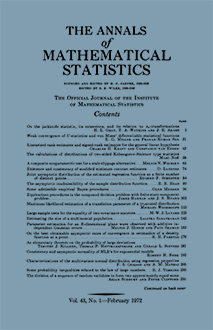Abstract
The classical Lindeberg-Feller CLT for sums of independent random variables (rv's) provides more than the convergence in distribution of the sum to a normal law. The independence of summands also guarantees the weak convergence of all finite dimensional distributions of an a.e. sample continuous stochastic process (suitably defined in terms of the partial sums) to those of a Gaussian process with independent increments, namely, the Wiener process. Moreover, the distributions of said process converge weakly to Wiener measure on $C\lbrack 0, 1\rbrack$, the latter result being known as an invariance principle, or functional CLT, an idea originating with Erdos and Kac [10] and Donsker [5], then developed by Billingsley, Prohorov, Skorohod and others. The present work contains an invariance principle for a certain class of martingales, under a martingale version of the classical Lindeberg condition. In the case of sums of independent rv's, our results reduce to the conventional invariance principle (see, for example, Parthasarathy [16]) in the setting of the classical Lindeberg-Feller CLT. Theorem 1 contains a type of martingale characteristic function convergence which is strictly analogous to the classical CLT, while Theorem 2 provides weak convergence of finite dimensional distributions to those of a Wiener process, followed by (Theorem 3) the weak convergence of corresponding induced measures on $C\lbrack 0, 1\rbrack$ to Wiener measure, thus entailing an invariance principle for martingales. Notation and results are listed in Section 2. Section 3 defines the Lindeberg condition for martingales and gives it several equivalent forms. Sections 4 and 5 contain the proofs of Theorems 1 and 2, respectively, while Theorem 3 is proved in Section 6 by use of a martingale inequality derived from an upcrossing inequality of Doob [7]. Section 7 contains brief remarks. Among the large literature on CLT's for sums of dependent rv's, mention of a martingale CLT is first made by Levy [12], [13], followed by Doob [6] page 383. Billingsley [2] and Ibragimov [11] gave a version for stationary ergodic martingales, and Csorgo [4] considered related problems. The author also knows of Dvoretsky [8]. Invariance principles for various dependent rv's were found by Billingsley [1], and in [3] for stationary ergodic martingales, the latter result being given by Rosen [17] for bounded summands. The present Theorem 3 relaxes the stationarity and ergodicity requirements of Billingsley's Theorem (23.1) of [3]. Since preparing the original version of this paper, the author's attention has been drawn to Dvoretsky [9], which announces a result strongly resembling the present Theorem 2, and to the CLT [14] and invariance principle [15] for reversed martingales, due to Lyones. The methods of Section 5 are owed to Billingsley [2] (who in turn acknowledges a "debt to Levy") and to ideas given by Dvoretsky [8]. Finally, I wish to thank Dr. C. C. Heyde, for making a vital remark, and Mr. David Scott, for helpful criticism.
Citation
B. M. Brown. "Martingale Central Limit Theorems." Ann. Math. Statist. 42 (1) 59 - 66, February, 1971. https://doi.org/10.1214/aoms/1177693494
Information





